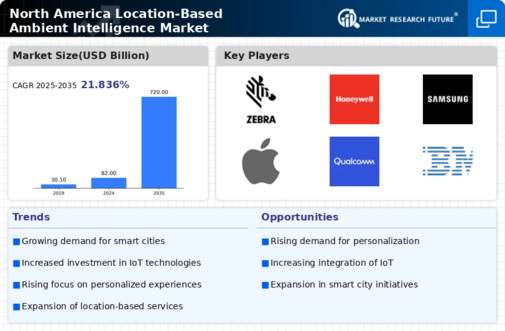Advancements in IoT Technologies
The location based-ambient-intelligence market is significantly influenced by advancements in Internet of Things (IoT) technologies. The proliferation of connected devices has enabled seamless data collection and analysis, facilitating the development of intelligent systems that respond to user behavior and preferences. In North America, the number of IoT devices is projected to reach over 30 billion by 2025, creating vast opportunities for the location based-ambient-intelligence market. These devices, equipped with sensors and location-tracking capabilities, provide valuable insights that enhance operational efficiency and customer engagement. Moreover, the integration of IoT with artificial intelligence further amplifies the potential of ambient intelligence, allowing for predictive analytics and automated decision-making. This driver underscores the importance of technological innovation in propelling the growth of the location based-ambient-intelligence market.
Growth of Smart Cities Initiatives
The location based-ambient-intelligence market is experiencing growth driven by the rise of smart cities initiatives across North America. Urban areas are increasingly adopting intelligent infrastructure that utilizes location-based technologies to enhance urban living. These initiatives aim to improve transportation systems, energy efficiency, and public safety through the integration of ambient intelligence. For instance, cities are deploying smart traffic management systems that utilize real-time data to optimize traffic flow and reduce congestion. As of 2025, it is estimated that investments in smart city projects will exceed $100 billion in North America, creating substantial opportunities for the location based-ambient-intelligence market. This driver emphasizes the transformative potential of urban innovation in shaping the future landscape of the industry.
Increased Focus on Data Privacy and Security
The location based-ambient-intelligence market is increasingly shaped by a heightened focus on data privacy and security. As businesses collect and utilize vast amounts of location data, concerns regarding consumer privacy have escalated. In North America, regulatory frameworks are evolving to address these concerns, with many states implementing stricter data protection laws. This shift compels organizations to adopt robust security measures and transparent data handling practices. According to industry reports, nearly 60% of consumers express apprehension about how their location data is used, which could impact their willingness to engage with location-based services. Consequently, companies that prioritize data privacy are likely to gain a competitive edge in the location based-ambient-intelligence market, fostering trust and encouraging user adoption. This driver highlights the critical balance between innovation and ethical data practices.
Rising Demand for Enhanced Customer Experiences
The location based-ambient-intelligence market is witnessing a notable surge in demand for enhanced customer experiences. Businesses are increasingly leveraging location-based data to tailor services and products to individual preferences. This trend is particularly evident in retail, where companies utilize ambient intelligence to create personalized shopping experiences. According to recent data, approximately 70% of consumers express a preference for personalized interactions, indicating a strong market potential. As organizations strive to meet these expectations, investments in location-based technologies are expected to rise, driving growth in the industry. Furthermore, the integration of real-time data analytics allows businesses to respond swiftly to customer needs, thereby fostering loyalty and increasing sales. This driver highlights the critical role of customer-centric strategies in shaping the future of the location based-ambient-intelligence market.
Emergence of Location-Based Marketing Strategies
The location based-ambient-intelligence market is significantly impacted by the emergence of location-based marketing strategies. Businesses are increasingly recognizing the value of targeting consumers based on their geographic location, allowing for more effective marketing campaigns. This approach enables companies to deliver personalized advertisements and promotions to potential customers in real-time, enhancing engagement and conversion rates. Recent studies indicate that location-based marketing can increase customer engagement by up to 30%, underscoring its effectiveness. As more organizations adopt these strategies, the demand for location-based technologies is expected to rise, further propelling the growth of the location based-ambient-intelligence market. This driver illustrates the evolving nature of marketing in an increasingly connected world.

















Leave a Comment